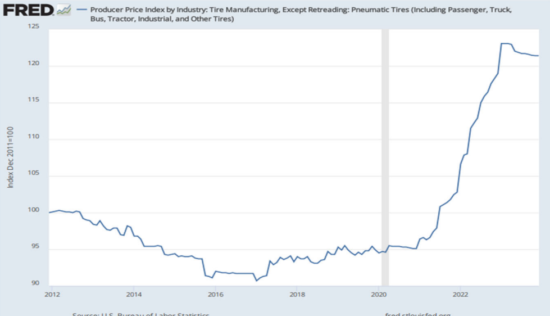Tyremakers sued in US class action antitrust lawsuit – public communications and high prices at centre of case
 Sharp price increases in recent years are amongst the factors that have prompted the suit (Source: Rena Sampayan vs Tyremakers)
Sharp price increases in recent years are amongst the factors that have prompted the suit (Source: Rena Sampayan vs Tyremakers)
Days after the European Commission announced that it is investigating a number of leading tyre manufacturers in relation to allegations of price-fixing, the same companies have become the subject of a similar class-action lawsuit in the USA. The class action relates to “…purchases of tyres within four years prior to the filing” – which clearly relates to a potentially enormous number of tyres. The case basically alleges that the named tyremakers colluded to raise and sustain higher tyre prices and that such action was at least partly facilitated via public communications. The named tyremakers have already denied price fixing and stated their compliance with the law and their cooperation with investigations in relation to the EC investigation.
The US lawsuit names both the European head offices and their North American legal entities. Specifically, “Continental Aktiengesellschaft; Continental Tire the Americas, LLC; Compagnie Générale des Établissements; Michelin North America, Inc.; Nokian Tyres plc; Nokian Tyres Inc; Nokian Tyres U.S. Operations LLC; The Goodyear Tire & Rubber Company; Pirelli & C. S.p.A.; Pirelli Tire LLC; Bridgestone Corporation; Bridgestone Americas, Inc.” are all named in the suit. Naturally, Goodyear is the only firm in the suit not to have both its headquarters and the US division named since Goodyear is based in Akron, Ohio, USA.
The case adds further detail to the more general information released by the European Commission relating to its investigation. Specifically, the case alleges that the named tyre makers and potentially other “unidentified Doe Defendants” made “illegal agreement[s]” to “artificially increase and fix the prices of new replacement tyres for passenger cars, vans, trucks and buses” sold in the US.
Furthermore, a relatively small detail of the European case is brought to the forefront of US filing. We now know that the allegation is that the defendants “coordinated price increases, including through public communications.” Of course, that doesn’t rule out other means, but this wording is the clearest suggestion of the specific allegation that prices increases were in some way managed via public communications.
The rationale for the US case is that the defendants coordinated “sudden and dramatic parallel price increases, which absent a conspiracy to fix prices, ran contrary to their economic interests” as well as the “high level of market concentration in the tyre market”.
The second tranche of arguments against the tyremakers appears somewhat circumstantial. For example, “significant barriers to entry” plus a “lack of economic substitutes for tyres” as well as the “standardization of tyres with a high degree of interchangeability” and “the myriad opportunities that employees of defendants had to conspire” could potentially be described as opportunity and perhaps motive, but such arguments alone don’t explicitly prove that any alleged collusion took place.
Further details of the allegations
Setting the scene, the case describes the US tyre market as “oligopolistic” and says that in 2022, Bridgestone, Michelin, and Goodyear sales made up 64 per cent of the total replacement tyre market (see pie chart), which the plaintiff says results in a market “more susceptible to cartelisation”.
When it comes to facts, the case centres on the sharp rises in tyre prices many different international markets have experienced in recent years. The US case specifically suggests the US tyre price increases have been driven by “lock-step price increases” by the named tyremakers.
Furthermore, the case argues that tyre prices are too high and have risen too quickly: “between 2021 and 2023, the average price of tyres rose 21.4 per cent, a rate of increase more than 70 per cent higher than core inflation”. The case also suggests “prices for tyres have remained high despite easing inflation and dissipating effects of the COVID-19 pandemic.”
The case describes the US tyre market as “oligopolistic”, pointing to the strong position of Goodyear, Michelin and Bridgestone (Source: Rena Sampayan vs Tyremakers)
As well as criticising the rate of tyre price rises in the US and their sustained level, the case is also suspicious about tyre unit sales volumes: “Sales volume also did not suffer due to price increases, which would normally be seen in a price-competitive market.
Citing Continental as an example, the case argues that “sales volume rose by 19.3 per cent in 2022. Their annual report from that year indicates “agreements reached with customers on price adjustments and to offset inflation-related effects had a positive impact on the sales performance of the automotive group sector.”
In another example, the plaintiff cites Goodyear’s Q1 2022 earnings call in which then CFO, Darren Wells, told investors “[Goodyear’s] increase in the replacement tyre prices more than offset [its] costs.”
Anyone wondering who brought the case may be interested to learn that Rena Sampayan, a resident of the State of California, is named as the plaintiff. The court documents add that she personally “purchased tyres within the State of California directly from Defendant Goodyear,” according to the legal filings.
Commenting on the reports, US news sources report that it is common practice for private civil antitrust lawsuits to follow comparable European Commission investigations.
In summary, with allegations prompted by tyre price increase circumstances that are common in different regions around the world, the manner in which tyremakers have communicated price information increases appears to be at the centre of the US case. Quite how the plaintiff will demonstrate that fast-moving prices alone in the days of online working and digital technology actively demonstrates collusion, remains to be seen.






Comments